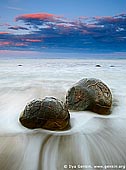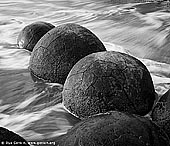Moeraki Boulders
Moeraki, Otago, New Zealand
The Moeraki Boulders are huge spherical stones, found lying along Koekohe Beach between Moeraki and Hampden on New Zealand's Otago coast. They occur scattered either as isolated or clusters of boulders within a stretch of beach where they have been protected in a scientific reserve. The erosion by wave action of mudstone, comprising local bedrock and landslides, frequently exposes embedded isolated boulders. These boulders are grey-colored septarian concretions, which have been exhumed from the mudstone enclosing them and concentrated on the beach by coastal erosion. The boulders weigh several tonnes and are up to three metres in diameter.
Local Maori legends explained the boulders as vegetables (gourds, kumaras and calabashes) washed ashore from the large sailing canoe Arai-te-uru when it was wrecked upon landfall in New Zealand hundreds of years ago. This legend tells of the rocky shoals that extend seaward from Shag Point as being the petrified hull of this wreck and a nearby rocky promontory as being the body of the canoe's captain. This fits well with other Maori legends telling that everything was gigantic in those ancient ages.
Scientists explain the Moeraki boulders as septarian concretions, were formed in ancient sea floor sediments. They were created by a process similar to the formation of oyster pearls, where layers of material cover a central nucleus or core. For the oyster, this core is an irritating grain of sand. For the boulders, it was a fossil shell, bone fragment, or piece of wood. Lime minerals in the sea accumulated on the core over time, and the concretion grew into perfectly spherical shapes up to three metres in diameter. The original mudstone seabed has since been uplifted to form coastal cliffs. Erosion of the cliffs has released the three tonne captive boulders, which now lie in a haphazard jumble across the beach. Further erosion in the atmosphere has exposed a network of veins, which gives the boulders the appearance of turtle shells.
The Moeraki Boulders are located on Koekohe Beach between Moeraki and Hampden, about 75 km north of Dunedin and about 40 km south of Oamaru and accessible by Moeraki Boulders Road followed by a short walk along the beach. You will also find the Moeraki Boulders Cafe, Bar and Gift Shop. Access to the beach from the visitor centre costs $2 per person. You can also drive about 300m south from the main road and use the free public carpark and free access to the beach.
Similar boulders can be found at Shag Point, and the nearby swimming beach of Katiki. Also very similar boulders, which are as much as three metres in diameter and called "Koutu Boulders", lying on the beach between Koutu and Kauwhare points along the south shore of the Hokianga Harbour of Hokianga, North Island, New Zealand. In Hawke's Bay in the North Island, scientists have found that the central core of similar boulders contained perfectly preserved skeletons of turtles, sea snails and extinct reptiles, such as plesiosaurs.
About the Artist
I'm Ilya Genkin - an internationally recognised Australian landscape and fine art photographer offering wall art prints. My passion for capturing the beauty of nature and our world translates into striking photographic prints that bring life, emotion, and inspiration to any space. From tranquil seascapes to dramatic mountainscapes, each image is a reflection of my vision and dedication to the art of photography.
Read more about Ilya Genkin and shop fine art prints online from his collection.
Wall Art Prints Featuring Fine Art Landscape Photography
Explore my extensive collection of wall art prints - crafted with the highest-quality materials to suit every style and budget. Whether you're looking for a luxurious, ready-to-hang piece or a beautifully printed work to frame yourself, each photograph is available in several premium formats: Gallery-quality Fine Art Paper Prints - ready for framing, and Professional Canvas Prints - classic and timeless texture.
Each artwork is meticulously printed and made-to-order to ensure you receive a piece that elevates your home, office, or commercial space. Buy fine art prints online to suit your style.
Artworks for Interior Designers, Home Stylists, and Architects
I collaborate with interior designers, home stylists, and architects to create bespoke wall art prints tailored to your project's aesthetic, colour palette and interior design needs. Prints can be customised and sized to complement your space perfectly. All pieces are made-to-order, and pricing varies based on size, quantity, and shipping.
Contact me to discuss your project and request a personalised quote.
Why Choose Ilya Genkin Photography?
By choosing my work, you're not just acquiring exceptional art - you're supporting an independent Australian artist and contributing to a vibrant local creative community. Every purchase directly helps sustain and grow this craft, bringing authentic and meaningful art into your life.
Request a free mockup to see how a chosen photograph will look in your space before you buy.
Start your journey today - shop our wall art collection, purchase with confidence, or order custom prints today and transform your walls with fine art photography.
Fine Art Landscape Photography
Information
Photography Guides
Online Store Opens 24/7
Email:
Phone: +61 (0) 421 055 613
Crafted with care for the planet - using sustainable materials and eco-friendly packaging.
Ilya Genkin Photography acknowledges the Traditional Custodians of the land on which we operate, live and gather as employees, and recognise their continuing connection to land, water and community. We pay respect to Elders past, present and emerging.









